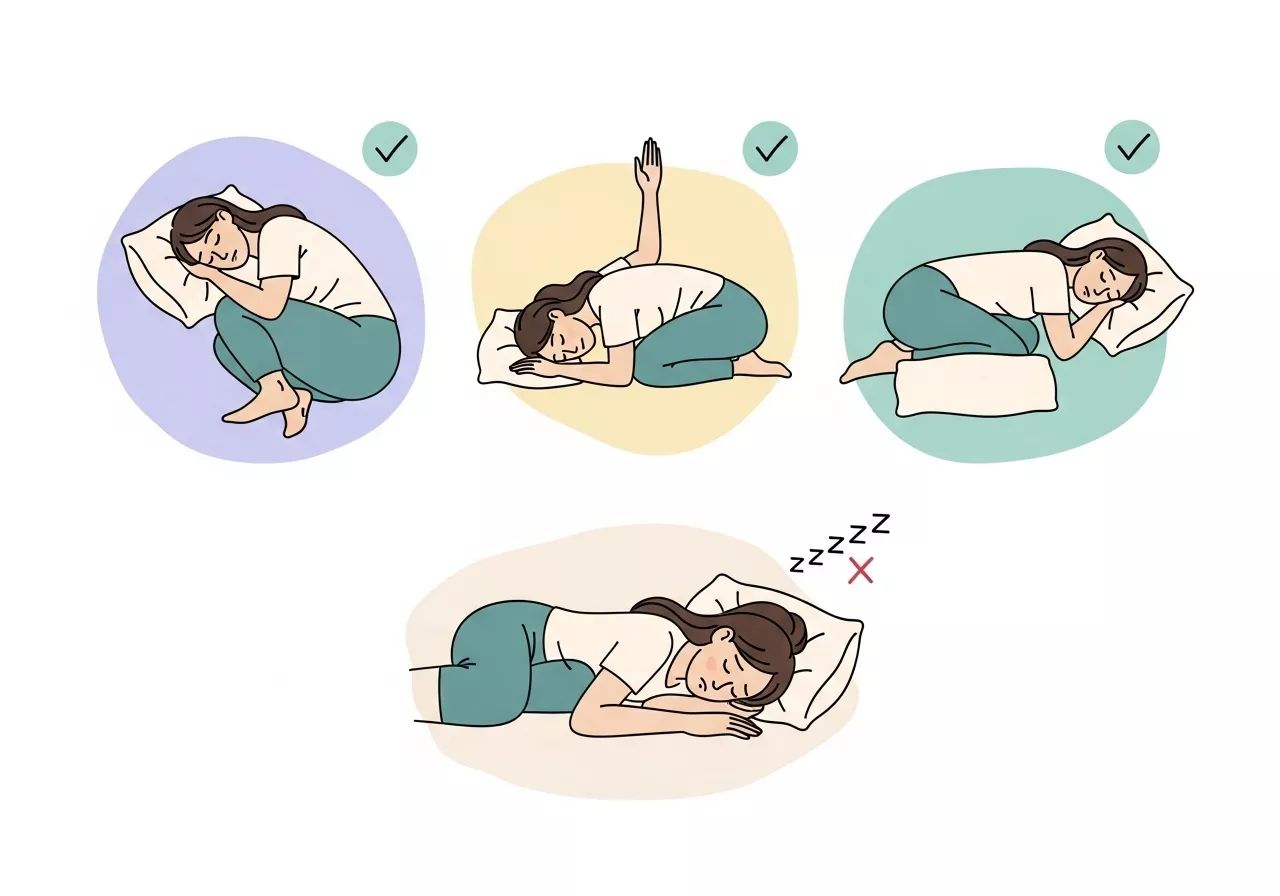Experiencing hair loss can be distressing, but incorporating specific yoga poses into your routine may help control hair fall and promote faster regrowth.

These poses enhance blood circulation to the scalp, strengthen hair follicles, and reduce stress—a common contributor to hair loss.
1. Matsyasana (Fish Pose)
Matsyasana is highly recommended for controlling hair fall and encouraging hair growth. Regular practice can lead to stronger, healthier hair within a month.

How to Perform:
- Lie on your back with legs extended and arms alongside your body.
- Slide your hands under your hips, palms facing down.
- Press your forearms and elbows into the floor, lifting your chest and head.
- Tilt your head back so the crown touches the floor.
- Hold for a few breaths, then gently release.
2. Sasangasana (Rabbit Pose)
This pose alleviates hair loss issues like hair fall and dandruff by promoting blood flow to the scalp and enhancing body awareness through breathing.

How to Perform:
- Kneel on the floor with knees hip-width apart.
- Hold your heels with your hands.
- Inhale, tuck your chin to your chest, and exhale as you roll forward, lifting your hips toward the ceiling.
- Try to touch your forehead to your knees and the crown of your head to the floor.
- Hold for a few breaths, then gently release.
3. Adho Mukha Svanasana (Downward-Facing Dog Pose)
This pose increases blood circulation to the scalp, reducing hair fall. It also stretches the neck and spine, relieving stress.

How to Perform:
- Start on your hands and knees, with wrists under shoulders and knees under hips.
- Spread your fingers wide and press firmly into the mat.
- Tuck your toes and lift your knees off the floor, extending your legs and raising your hips toward the ceiling.
- Form an inverted “V” shape with your body, keeping your head between your arms.
- Hold for a few breaths, then gently release.
4. Pavanamuktasana (Wind-Relieving Pose)
This beginner-friendly pose enhances blood circulation and reduces belly fat, indirectly supporting hair health.

How to Perform:
- Lie on your back with legs extended.
- Inhale, then exhale as you draw both knees toward your chest.
- Clasp your hands around your knees.
- Hold for a few breaths, then gently release.
5. Meditation
Meditation reduces stress and anxiety, which are significant contributors to hair loss.

How to Perform:
- Sit comfortably with legs crossed.
- Close your eyes and focus on your breath.
- Breathe normally, allowing your mind to relax.
- Practice for several minutes daily.
6. Vajrasana (Thunderbolt Pose)
Vajrasana is a simple yet effective pose that helps improve digestion and increases blood circulation to the scalp, promoting healthier hair growth.

It is one of the few poses that can be performed immediately after a meal.
How to Perform:
- Kneel on the floor with your knees and feet together, sitting back on your heels.
- Keep your spine straight, hands resting on your thighs, and palms facing down.
- Close your eyes and focus on your breath.
- Hold this position for 5–10 minutes daily for best results.
7. Sarvangasana (Shoulder Stand Pose)
Sarvangasana is known as the “queen of all yoga poses” because it benefits the entire body, including enhancing blood circulation to the scalp.

This inverted pose helps nourish hair follicles and prevent hair fall.
How to Perform:
- Lie on your back with legs extended and arms alongside your body.
- Lift your legs, hips, and back off the ground, supporting your lower back with your hands.
- Keep your legs straight and perpendicular to the floor, forming a straight line from shoulders to feet.
- Hold the pose for a few breaths, then slowly lower your body back to the ground.
8. Kapalabhati Pranayama (Breathing Exercise)
Kapalabhati Pranayama is a breathing technique that detoxifies the body, enhances oxygen flow to the scalp, and helps reduce stress, which is crucial for controlling hair fall.

How to Perform:
- Sit in a comfortable position with your back straight.
- Take a deep breath in and exhale forcefully through your nose while pulling your stomach inward.
- Repeat this rhythmic breathing for a few minutes daily.
9. Uttanasana (Standing Forward Bend Pose)
Uttanasana boosts blood circulation to the scalp and relieves stress, which is a common cause of hair fall. It also stretches the spine and hamstrings, promoting relaxation.

How to Perform:
- Stand with your feet hip-width apart.
- Inhale, and as you exhale, bend forward from your hips, allowing your hands to touch the floor (or rest on your shins if you can’t reach the floor).
- Keep your head relaxed and let it hang freely.
- Hold this pose for a few breaths, then gently return to a standing position.
10. Anulom Vilom (Alternate Nostril Breathing)
Anulom Vilom is a calming breathing technique that reduces stress and promotes better oxygenation, indirectly supporting hair health.

How to Perform:
- Sit comfortably with your spine erect.
- Use your right thumb to close your right nostril and inhale deeply through your left nostril.
- Close your left nostril with your ring finger, release your thumb, and exhale through your right nostril.
- Repeat the process, alternating nostrils for 5–10 minutes.
11. Bhujangasana (Cobra Pose)
Bhujangasana is a rejuvenating backbend pose that strengthens the spine, improves blood flow to the scalp, and reduces stress.

It stimulates the scalp, encouraging hair growth while also relieving tension in the back and shoulders.
How to Perform:
- Lie on your stomach with your legs extended and the tops of your feet resting on the floor.
- Place your palms under your shoulders, elbows close to your body.
- Inhale and gently lift your chest off the floor, keeping your elbows slightly bent.
- Ensure your shoulders are away from your ears and your neck is relaxed.
- Hold the pose for a few breaths, then exhale and slowly lower yourself back to the floor.
This pose not only supports healthier hair but also improves posture and boosts energy levels.
Tips for Healthy Hair: A Comprehensive Guide
Maintaining healthy hair requires a holistic approach that includes proper care, a balanced diet, and lifestyle adjustments. Here’s a detailed breakdown of tips to nurture your hair:

1. Maintain a Balanced Diet
Your hair’s health reflects your overall nutrition. Ensure your diet includes essential nutrients that promote hair growth and strength:
- Protein: Hair is primarily made of keratin, a type of protein. Include foods like eggs, fish, poultry, beans, and nuts to provide adequate protein.
- Iron and Zinc: Iron ensures oxygen delivery to hair follicles, while zinc supports follicle health. Incorporate spinach, lentils, pumpkin seeds, and lean red meat.
- Vitamins: Vitamin A stimulates sebum production, which moisturizes the scalp, while Vitamin E enhances blood circulation. Include sweet potatoes, avocados, almonds, and carrots.
- Omega-3 Fatty Acids: Found in salmon, flaxseeds, and walnuts, these help maintain a healthy scalp and add shine to your hair.
- Biotin (Vitamin B7): Biotin strengthens hair and prevents thinning. Foods like eggs, bananas, and nuts are excellent sources.
2. Stay Hydrated
Dehydration weakens the hair shaft and makes your hair prone to breakage. Drink at least 8–10 glasses of water daily to keep your scalp and hair hydrated.
You can also incorporate hydrating foods like cucumbers, watermelon, and oranges into your diet.
3. Follow a Proper Hair Care Routine
Adopting a consistent and gentle hair care routine is vital:
- Regular Washing: Cleanse your scalp 2–3 times a week using a mild, sulfate-free shampoo to remove dirt and excess oil without stripping natural moisture.
- Conditioning: Apply conditioner to the lengths and ends of your hair to retain moisture and prevent tangling. Avoid applying it directly to the scalp to prevent buildup.
- Hair Oils: Massage your scalp with natural oils like coconut, argan, or castor oil 1–2 times a week to nourish the roots and improve blood circulation.
- Avoid Overwashing: Washing hair daily can strip essential oils, leading to dryness and breakage.
4. Minimize Heat Styling
Excessive use of heat styling tools like straighteners, curling irons, and blow dryers can weaken the hair and cause split ends. If heat styling is necessary:
- Use a heat protectant spray to shield your hair.
- Opt for the lowest heat setting and limit the frequency of styling.
- Air-dry your hair whenever possible instead of using a blow dryer.
5. Protect Your Hair from Environmental Damage
Sun exposure, pollution, and harsh weather can harm your hair. Take these precautions:
- Wear a hat or scarf to protect your hair from UV rays and dust.
- Use hair care products with SPF for added sun protection.
- Rinse your hair with fresh water before and after swimming in chlorinated or salty water to reduce damage.
6. Practice Scalp Care
A healthy scalp is the foundation for strong and shiny hair. Here’s how to care for it:
- Scalp Exfoliation: Use a gentle scalp scrub once a month to remove product buildup and dead skin cells.
- Massage: Regular scalp massages with warm oil stimulate blood circulation and promote hair growth.
- Anti-Dandruff Treatments: If you have dandruff, use specialized shampoos with ingredients like ketoconazole or tea tree oil.
7. Sleep Well
Sleep is crucial for overall health, including hair regeneration:
- Aim for 7–8 hours of sleep daily to minimize stress and promote hair growth.
- Use a silk or satin pillowcase to reduce friction, which can cause hair breakage and frizz.
8. Manage Stress
Stress is a leading cause of hair fall. Incorporate stress-relief techniques into your daily routine:
- Practice yoga, meditation, or deep breathing exercises to calm your mind.
- Engage in hobbies or activities you enjoy to reduce anxiety.
- Maintain a work-life balance to avoid burnout.
9. Avoid Harsh Chemical Treatments
Chemical treatments like coloring, perming, and straightening can weaken hair over time. Opt for natural alternatives:
- Use henna or herbal dyes instead of synthetic colors.
- Limit exposure to bleach and ammonia-based products.
10. Trim Regularly
Regular trims every 6–8 weeks prevent split ends and maintain the health of your hair. This also helps in faster and healthier hair growth by eliminating damaged portions.
11. Use Natural Remedies
Natural ingredients can do wonders for hair health. Some examples include:
- Aloe Vera: Apply aloe vera gel directly to your scalp to soothe irritation and boost hydration.
- Onion Juice: Rich in sulfur, onion juice can improve circulation to the scalp and promote hair growth.
- Fenugreek Seeds: Soak them overnight, grind into a paste, and apply to your scalp to combat dandruff and hair fall.
12. Limit Tight Hairstyles
Tight ponytails, buns, or braids can lead to traction alopecia, causing hair breakage and thinning. Opt for loose, gentle hairstyles, especially during sleep.



